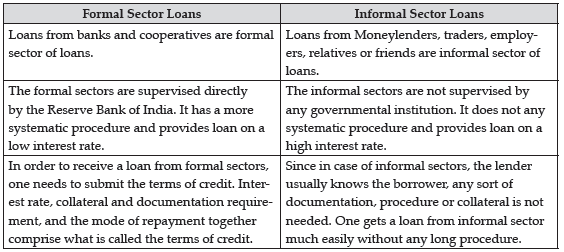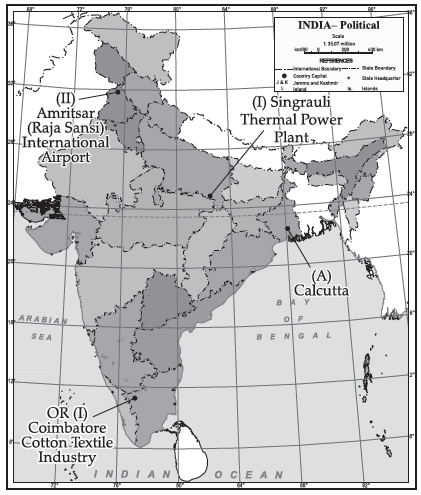Please refer to Class 10 Social Science Sample Paper Term 2 Set D with solutions below. The following CBSE Sample Paper for Class 10 Social Science has been prepared as per the latest pattern and examination guidelines issued by CBSE. By practicing the Social Science Sample Paper for Class 10 students will be able to improve their understanding of the subject and get more marks.
CBSE Class 10 Social Science Sample Paper for Term 2
Section – A
1. Who organized the Dalits into the ‘Depressed Classes Association’ in 1930? Describe his achievements.
Answer : Dr. B.R. Ambedkar organised the dalits into the ‘Depressed Classes Association’ in 1930. He was the Chairman of the drafting Committee in the Constituent Assembly and was the main architect behind the Constitution of India. He was also the free India’s first law minister.
2. Classify industries on the basis of capital investment. How are they different from one another? Explain with examples.
Answer : On the basis of Capital Investment, industries are classified into two categories:
(i) Large scale indusby:If the capital investmentin an industry is more than one crore,it isconsidered a large-scale industry. For example,Iron and Steel Industry.
(ii) Small scale industry: On the other hand, if the capital investment in an industry is less than one crore, it is considered a small-scale industry. For example, Toy Industry.
3. How is Democratic government known as responsive government? Explain with an example.
Answer : Democracy produces a government that is accountable, legitimate and responsive to the needs of the citizens. It is based on the idea of deliberation and negotiation and develops a mechanism for the citizens to hold the government accountable. For example, through pressure groups or public protests a democratic government can check the popularity of its decisions and then response by altering the mechanism of administering according to majority’s choice.
4. Why are service conditions of formal sector loans better than informal sector? Explain.
Answer : The services of formal sector loans are better than informal sectors loans due to following reasons:
(i) Formal sector loans are more systematic in functioning in comparison to the informal sectors.
(ii) Formal sectors charge low interest rates whereas the informal sectors charge a much higher rate of interest on their loans.
(iii) The formal sectors are supervised directly by the Reserve Bank of India while the informal sectors have no such supervision over them.
5. Read the data in the table given below and answer the questions that follow:

5.1 On the basis of above given data, give one reason why Indian Iron and Steel industry is not able to perform to its full potential?
Answer : Indian Iron and Steel Industry is not able to perform to their full potential because of the following reasons:
(i) Limited availability and high costs of coking coal.
(ii) Low productivity of labours.
(iii) Irregular supply of energy.
(iv) Poor Infrastructure.
5.2 Which region of India has the highest concentration of Iron and Steel Industry? Why?
Answer : Chhotanagpur plateau region has the maximum concentration of iron and steel industries. Various factors like low cost of iron ore, high grade raw materials in proximity, cheap labour and vast growth potential in the home market make this region suitable for the development of iron and steel industry.
Section – B
6. How has liberalisation of trade and investment policies helped the globalization process?
OR
Why had the Indian government put barriers to foreign trade and foreign investment after independence? Analyse the reasons.
Answer : (i) The removal of barriers or restrictions set by the government is known as liberalisation.
(ii) With liberalisation of trade, businesses are allowed to make decisions freely about what they wish to import or export.
(iii) The government imposes much less restrictions than before and is therefore said to be more liberal. This has made the foreign trade and investment easier, helping globalisation in the process.
OR
The Indian government, after Independence, had put barriers to foreign trade and foreign investment.
(i) This was considered necessary to protect the producers within the country from foreign competition.
(ii) Industries were just coming up in the 1950s and 1960s, and competition from imports at that stage would not have allowed these industries to come up.
(iii) Thus, India allowed imports of only essential items such as machinery, fertilisers, petroleum etc.
7. How is Democracy accountable and responsible to the needs and expectations of the Citizens? Analyse.
Answer : A democratic government is accountable and responsive to the needs and expectation of the citizen:
(i) Democracy is based on the idea of deliberation and negotiation. It follows the whole procedure and though it is time-consuming, its decisions may be both more acceptable to the people and more effective.
(ii) Democracy offers transparency to the citizens, i.e., if a citizen wants to know if a decision was taken through right procedure, he or she has the right and the means to examine the process of decision making.
(iii) A democratic government develops mechanisms for citizens to hold the government accountable and mechanisms for citizens to take part in decision making whenever they think fit.
8. “The First World War created favourable conditions for the development of industries in India.” Explain.
Answer : The First World War created favourable conditions for the development of industries in India:
(i) During the First World War, the British mills were busy with war production to meet the needs of the army. Due to this the Manchester imports into India declined.
(ii) Suddenly, Indian mills had a vast home market to supply. As the war prolonged, Indian factories were called upon to supply war needs. Jute bags, cloth for army uniforms, tents and leather boots, horse and mule saddles and a host of other items were required.
(iii) New factories were set up and old ones ran multiple shifts. Many new workers were employed and everyone was made to work longer hours. Over the war years industrial production boomed.
Section – C
9. In what ways does the Reserve Bank of India supervise the functioning of Banks?
OR
Explain any two features each of formal sector loans and informal sector loans.
Answer : The Reserve Bank of India supervises the functioning of the banks in the following ways:
(i) The Reserve Bank of India supervises the functioning of formal sources of loans. For instance, the banks maintain a minimum cash balance out of the deposits they receive. The RBI monitors the banks in actually maintaining cash balance.
(ii) The RBI sees that the banks give loans not just to profit-making businesses and traders but also to small cultivators, small scale industries, to small borrowers etc.
(iii) Periodically, the banks have to submit information to the RBI on how much they are lending, to whom, at what interest rate, etc.
The supervision of RBI on the functioning of banks is necessary as it ensures the safety of people’s deposits and sees that even the poor gets benefitted from the services of formal sectors and not just the rich and upper class.
OR
Two features of formal sector loans and informal sector loans are

10. What are the conditions under which democracies accommodate social diversities?
OR
“Democracies are not appearing to be very successful in reducing economic inequalities.” Analyse the statement.
Answer : The conditions under which democracies accommodate social diversities:
(i) It is necessary to understand that democracy is not simply rule by majority opinion. The majority always needs to work with the minority so that governments function to represent the general view. Majority and minority opinions are not permanent.
(ii) It is also necessary that rule by majority does not become rule by majority community in terms of religion or race or linguistic group, etc.
(iii) Rule by majority means that in case of every decision or in case of every election, different persons and groups may and can form a majority.
(iv) Democracy remains democracy only as long as every citizen has a chance of being in majority at some point of time.
(v) If someone is barred from being in majority on the basis of birth, then the democratic rule ceases to be accommodative for that person or group.
OR
Democracies do not appear to be very successful in reducing economic inequalities:
(i) Democracy allows the freedom to earn as much through any profession of choice. Though it benefits number a large number of people and the economic growth of a country, many people who are uneducated and unaware of the ways to create wealth for themselves still lies under the line of poverty.
(ii) A small number of ultra-rich enjoy a highly disproportionate share of wealth and incomes. Not only that, their share in the total income of the country has been increasing. Those at the bottom of the society have very little to depend upon. Their incomes have been declining. Sometimes they find it difficult to meet their basic needs of life, such as food, clothing, house, education and health.
(iii) The situation is much worse in some other countries. In Bangladesh, more than half of its population lives in poverty. People in several poor countries are now dependent on the rich countries even for food supplies.
Section – D
11. Read the given text and answer the following questions:
The Movement started with middle-class participation in the cities. Thousands of students left Government controlled schools and colleges, headmasters and teachers resigned, and lawyers gave up their legal practices. The Council Elections were boycotted in most provinces except Madras, where the Justice Party, the party of the non- Brahmans, felt that entering the council was one way of gaining some power-something that usually only Brahmans had access to.
The effects of Non-Cooperation on the economic front were more dramatic. Foreign goods were boycotted, liquor shops picketed and foreign cloth burnt in huge bonfires. The import of foreign cloth halved between 1921 and 1922, its value dropping from102 crore to57 crore. In many places merchants and traders refused to trade in Foreign goods or finance foreign trade. As the boycott movement spread, and people began discarding imported clothes and wearing only Indian ones, production of Indian Textile Mills and handlooms went up.
But this Movement in the cities gradually slowed down for a variety of reasons. Khadi cloth was often more expensive than mass produced mill cloth and poor people could not afford to buy it. How then could they boycott mill cloth for too long? Similarly, the boycott of British institutions posed a problem.
For the movement to be successful, alternative Indian institutions had to be set up so that they could be used in place of the British ones. These were slow to come up. So students and teachers began trickling back to government schools and lawyers joined back work in Government Courts.
11.1 What was the purpose of Justice Party to contest Elections to the Council in Madras?
Answer : The Rowlatt Act gave the government enormous powers to repress political activities, and allowed detention of political prisoners without trial for two years.
11.2 How was the effect of ‘Non-Cooperation on the economic front’ dramatic?
Answer : Martial law was imposed in Punjab to suppress political activities and protests arising due to the Rowlatt Act. General Dyer was given the command of the area.
11.3 Why the import of Foreign cloth between 1921 and 1922 saw changes?
Answer : Gandhiji launched a nationwide Satyagraha against the proposed Rowlatt Act (1919).
12. Read the given text and answer the following questions:
Manufacturing industries not only help in modernising agriculture, which forms the backbone of our economy, they also reduce the heavy dependence of people on agricultural income by providing them jobs in secondary and tertiary sectors. Industrial development is a precondition for eradication of unemployment and poverty from our country. This was the main philosophy behind public sector industries and joint sector ventures in India. It was also aimed at bringing down regional disparities by establishing industries in tribal and backward areas. Export of manufactured goods expands trade and commerce, and brings in much needed foreign exchange. Countries that transform their raw materials into a wide variety of finished goods of higher value are prosperous. India’s prosperity lies in increasing and diversifying its manufacturing industries as quickly as possible. Agriculture and industry are not exclusive of each other. They move hand in hand. For instance, the agro industries in India have given a major boost to agriculture by raising its productivity.
12.1 What is the importance of manufacturing industries?
Answer : Waterways are the cheapest means of transport. They are most suitable for carrying heavy and bulky goods. It is a fuel-efficient and environment friendly mode of transport.
12.2 Research and Development and Banking fall on which sector?
Answer : India has inland navigation waterways of 14,500 km in length.
12.3 What a country needs to develop to attract foreign manufacturing firms?
Answer : The Ganga River between Allahabad and Haldia (1620 km) is the National Waterway No. 1.
Section- E
13. 13.1 On the given outline Political Map of India, identify the place marked as A with the help of following information and write its correct name on the line marked near it.
(A) The place where Indian National Congress was held in September 1920.
13.2 On the same given map of India, locate the following:
(I) Singrauli Thermal Power Plant
OR
Coimbatore Cotton Textile Industry
(II) Amritsar (Raja Sansi) International airport
Answer :

